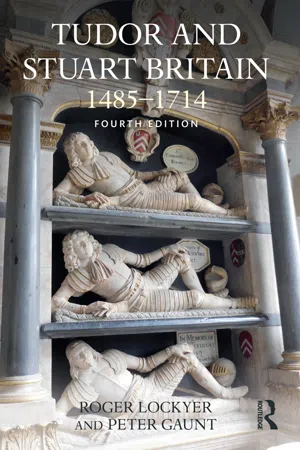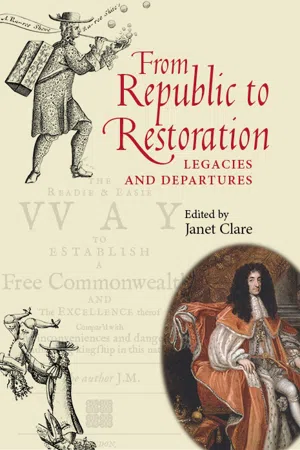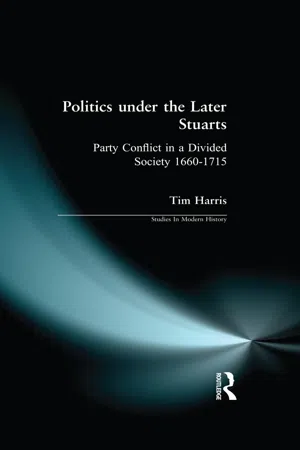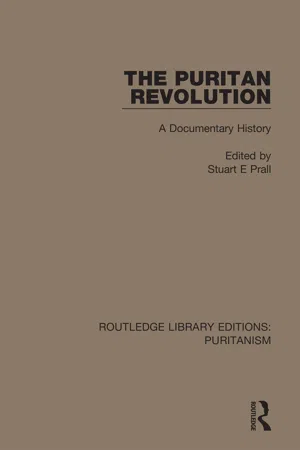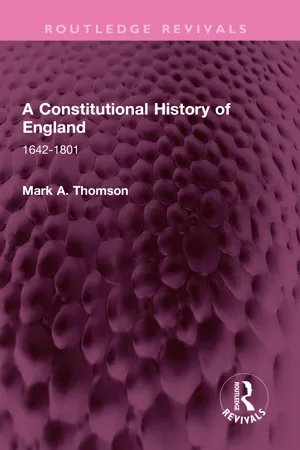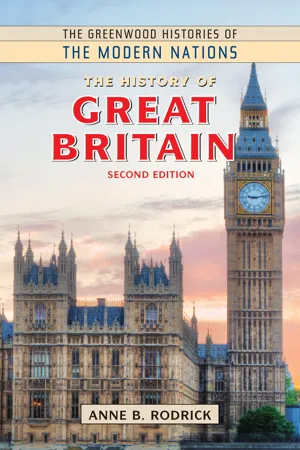History
The Stuart Restoration
The Stuart Restoration refers to the period in English history from 1660 to 1688 when the Stuart monarchy was restored to the throne after the Interregnum. This period saw the return of Charles II and James II to power, marking a significant shift in English politics and society following the English Civil War and the Commonwealth.
Written by Perlego with AI-assistance
Related key terms
Related key terms
1 of 4
Related key terms
1 of 3
8 Key excerpts on "The Stuart Restoration"
- eBook - ePub
Tudor and Stuart Britain
1485-1714
- Roger Lockyer, Peter Gaunt(Authors)
- 2018(Publication Date)
- Routledge(Publisher)
Charles IIThe Restoration and Charles II in perspective
The legacies of the mid-seventeenth century and the depth and durability of the changes wrought during the 1640s and 1650s are not entirely clear and give rise to continuing historical debate. The traditional view suggests that there had been a demonstrable change in political and constitutional power away from the Crown and towards Parliament and that although the return of Stuart kingship in 1660 led to the reversal of some of the specific statutes and means by which this had been achieved, the overall shift in power nonetheless survived to shape a very different type of post-Restoration monarchy. Similarly, traditional accounts argue that, while the Church of England also returned in 1660 and in many ways appeared to be the same as the pre-war Church, in reality things had altered – the Restoration Church lacked the authority and hold over the whole English (and Welsh) population that the Church had possessed during much of the Elizabethan and early Stuart period and, moreover, after 1660 religion became less central to the lives of many people and religious intensity and passions began to recede in public life, it is argued. These views were challenged in the late twentieth century by historians who tended to see in these areas greater continuity between the pre-war and the post-Restoration eras and to argue that the Restoration Crown and Church exercised much the same powers and held much the same positions as their early Stuart predecessors and also that religion and the role of the state Church remained throughout the Restoration era a central, vital and passionate element of everyday life as well as of government and politics. At the same time, some also came to recognize more sharply the role of the wider ‘public sphere’ in Restoration political life and to emphasize how the effective broadening of the parliamentary franchise because of inflation, the greater accessibility of printed news – print culture flourished, despite the tight censorship theoretically reimposed shortly after the Restoration – and of forums, including the new coffee houses, where such news could be discussed, and the expansion of towns and thus of urban political life all led on to a more informed, engaged and politicized public, who needed to be courted, and an energized public opinion, which needed to be respected by the political elite. - eBook - ePub
Restoration Politics, Religion and Culture
Britain and Ireland, 1660-1714
- George Southcombe, Grant Tapsell(Authors)
- 2009(Publication Date)
- Bloomsbury Academic(Publisher)
18 The heads of the traitors were displayed prominently, their dead gazes cast over London reminding its inhabitants of the past in all too obvious a form. Even more strikingly than this, the phrase ‘digging up the past’ was literalised in a particularly grotesque way when it was ordered that the bodies of Oliver Cromwell, Henry Ireton, and John Bradshaw should be exhumed. In an act of symbolic revenge they were hanged, dressed in their winding sheets, on the anniversary of the regicide 30 January 1661. Their heads were then put on spikes outside Westminster Hall. For almost 20 years Oliver Cromwell’s head looked down upon London. Oblivion? Hardly. The chief statesman of the 11 years that officially did not exist was ever present during the 20 years in which all Londoners were meant to forget that he had ever been alive. But it was, of course, not only the actions of the Restoration government that kept the past at the forefront of people’s minds. The interregnum was unforgettable. The past indelibly affected the present: the major political issues; the political languages used; and the political and religious decisions taken; all of these things bore the marks of the experiences that had preceded 1660. Just as Cromwell’s head watched over Restoration London, so the Restoration as a period was watched over by the ghosts of the civil war and interregnum, and they were ghosts who refused to lie down.This is key to understanding why, despite the apparent strength bestowed upon the restored monarchy by the settlement, the period remained turbulent. The Restoration was fundamentally affected by the English Revolution. The concept of the English Revolution is a controversial one, but its use is appropriate here. While the arguments supported by the teleological underpinnings of Whiggism and Marxism crumbled in the face of the detailed archival researches of revisionist historians, recently the notion of an English Revolution has been rescued from obsolescence partly because it has been redefined. The English Revolution is now seen less as a social and economic event and more as a cultural and intellectual process. As the erstwhile president of the United States, John Adams, had commented upon a very different revolution: ‘What do we mean by the Revolution? The war? That was no part of the Revolution; it was only an effect and consequence of it. The Revolution was in the minds of the people’.19 - eBook - ePub
From Republic to Restoration
Legacies and departures
- Janet Clare(Author)
- 2018(Publication Date)
- Manchester University Press(Publisher)
CHAPTER 2 Monarchy and commonwealth: ‘republican’ defences of monarchy at the Restoration Glenn BurgessIt can sometimes seem that the Restoration of the Stuart monarchy was received gratefully by a nation weary of confusion and worried by disorder. But whatever there was of weariness soon gave way to resurgent and uncompromising monarchism: in the Restoration ‘the cult of kingship flourished as never before’. This cult took various forms (Augustan, Platonic, Davidic, miraculous and feudal); but mostly it appeared as an absolutist theory of the divine right of kings, hard-nosed, rationalistic and juridical more than mystical.1 Of course, this is not all that there was to the Restoration; it is not even all that there was to Restoration royalism. Republican or quasi-republican critiques of monarchy were, before long, to make a powerful return, whereas royalist ideas are too easily caricatured as unthinking and uncritical enthusiasm for monarchy. A lot of recent research has shown that royalist political thought is more complicated and diverse than was once imagined. Most of this research has concentrated on the 1640s and 1650s,2 but it has implications for the later period:The very diversity of Royalist experiences during the Interregnum ensured that when Charles II returned to England his followers were scattered along a wide spectrum of attitudes and beliefs. This must surely have had profound implications – more than has often been appreciated – for the nature of the Restoration Settlement and the politics of the 1660s.3The present volume seeks to confront some of the easy caricatures, and to work across the divide of 1660, identifying continuities as well as ruptures. This chapter, as a contribution to this task, will explore one facet of ‘the broad, variegated and fractured identity’ of royalist thought,4 - eBook - ePub
The Stuart Age
England, 1603–1714
- Barry Coward, Peter Gaunt(Authors)
- 2017(Publication Date)
- Routledge(Publisher)
Currently, this continuity view still has much support among historians, who recognize that the monarchy, though strengthened by a conservative backlash in its favour in the early 1660s, faced the same problems it had faced before 1660: the triple problems of finance, ruling multiple kingdoms and religious divisions. They also rightly emphasize that religion was a (perhaps the) primary force in the politics of Restoration England.Yet it is now becoming clear that continuity can be carried too far. Some historians have redefined ‘politics’ so that it does not focus solely on institutions like parliament. According to John Miller, politics should be seen ‘in a wider sense than [that used by] most political historians, a sense closer to that employed by social historians interested in power relationships and dispute resolution, often within small communities’.2 Historians like Miller have shown that popular participation in and awareness of political issues increased greatly after 1660. This development of ‘the public sphere’ was not, of course, new. As has been seen, it was significant in the politics of late Elizabethan and early Stuart England. Yet the popular participation in politics and the ideological divisions (principally over religion) that had characterized the 1640s and 1650s intensified after 1660 and were carried over to shape the partisan politics of Restoration England. This was possibly one of the major consequences of the English Revolution.Before beginning a narrative analysis of Restoration politics, it is worth saying a little more about the current views briefly described above. First, it is important to stress the continuing strengths and weaknesses of the monarchy. Britain in the late seventeenth century was still a personal monarchy. Like their Tudor and early Stuart predecessors, later Stuart monarchs ruled as well as reigned. Like its predecessor too, the later Stuart monarchy had a central role in the politics of the country (arguably this is true until well into the nineteenth century). Although some of its powers were stripped away from it by the parliamentary legislation of 1641, the monarchy was restored unconditionally in 1660. Attempts to impose on Charles II limitations like those set out in the Treaty of Newport of 1648 and in earlier parliamentarian proposals for a settlement with the king – principally, parliamentary control of the militia and appointment of state officials – came to nothing. Furthermore, their fear and hatred of regicide and republicanism drove many MPs in the Cavalier Parliament to approve legislation outlawing numerous claims made by parliaments during the revolution, including the right to legislate without the king and to call parliaments without the king’s consent. It will be seen that the Cavalier Parliament gave Charles II massive powers of censorship, left untouched many of the king’s prerogative powers, and even allowed him to keep a standing army. Above all, within just over a decade of the Restoration, the royal government’s financial problems were considerably eased. - eBook - ePub
Politics under the Later Stuarts
Party Conflict in a Divided Society 1660-1715
- Tim Harris(Author)
- 2014(Publication Date)
- Routledge(Publisher)
The RestorationThe Restoration of monarchy in the spring of 1660 is normally seen as being genuinely popular. The King’s return, as one contemporary put it, was greeted with the ‘acclamations of all the people’, and met with ‘the greatest and most unanimous satisfaction that ever was perceiv’d in England’.1 Contemporaries were well aware, however, that this apparent unanimity in favour of restoring the King did not represent a genuine consensus. The High Anglican cleric, George Hickes, looking back on the Restoration in a sermon of 1684, commented that ‘then were strange things to be seen, Republicans with Royalists, Churchmen with Church-robbers, Rebels and Traytors with Loyal Subjects, Papists with Protestants, Episcopalians with Anti-Episcopalians, all agreed to bring in the King, or let him be brought in’.2 Clarendon thought that the Restoration was produced ‘by a union of contradictions, by a concurrence of causes’ which ‘never desired the same effects’.3It is a major theme of this book that the roots of party strife in England can be traced back to 1660, and the problems which the Restoration left unsolved. It will be the argument of this chapter that the Restoration was, indeed, a deeply contradictory affair, the product of an already divided society. The Restoration failed to heal these divisions, and the development of party conflict occurred as a result of the working out of these contradictions after a settlement which proved unsatisfactory to most of the different political groupings of 1660. I shall start by looking at the desire for the Restoration, and shall argue that the return of Charles II was genuinely popular. Republicanism did not die overnight, but after 1660 the republicans were a small minority, and the main political conflicts in Restoration England did not centre around tensions between those who supported the restoration of monarchy in 1660 and those who remained consistently opposed to it. Yet different people looked to the Restoration for very different reasons. When we consider, in turn, the different political and religious solutions desired by the various groups who supported the return of the Stuart monarchy, it was inevitable that the Restoration was not going to satisfy all groups. - eBook - ePub
The Puritan Revolution
A Documentary History
- Stuart E. Prall(Author)
- 2020(Publication Date)
- Routledge(Publisher)
VIII The RestorationJohn Evelyn has recorded the joy with which London welcomed the young king back to “his own” [2]. The disintegration of the Protectorate had proceeded rapidly after the death of Oliver Cromwell in the late summer of 1658. He had chosen as his successor his eldest son Richard—Tumbledown Dick”—rather than his abler fourth son Henry. The army refused to accept Richard as leader and he soon retired into the country, leaving the field to the army under Lambert and the newly restored Rump. At that point General George Monck brought his forces down from Scotland and recalled the old unpurged Long Parliament. This guaranteed a majority for the Presbyterian Royalists. The next step was inevitable-overtures went out to Charles.In The Declaration of Breda [1] Charles demonstrated his desire to forget the past and to pardon his own and his father’s enemies (with the approval of a new parliament). But while Charles was sincere in his desire to be magnanimous, the new Cavalier Parliament was not. Since the king got back his lands, his crown, and the constitution as it stood before civil war broke out in 1642, he could undoubtedly afford to be generous. Many Anglican gentry and clergy did not feel quite so forgiving since the mere return of the king was not considered sufficient redress of their grievances.All acts of parliament, since 1642, all decrees of the Council of State, and proclamations of the Lord Protector were declared null and void, and Charles Il’s reign was officially said to have begun on the day his father died—January 30, 1649. The years from 1642 to 1660 were stricken from the books. Many generations were to pass before Englishmen would once again take pride in the “Good Old Cause.”Of course these eighteen years were not to have been for nothing. Charles II never forgot that there was a point beyond which he dared not go. The people also remembered that there was a point beyond which the opposition to the crown should not go. And in any case the crown that Charles II put on in 1660 was the reformed crown of 1642, not the divine right crown of the years of his father’s personal rule. All had not been in vain. - eBook - ePub
A Constitutional History of England
1642-1801
- Mark A. Thomson(Author)
- 2023(Publication Date)
- Routledge(Publisher)
Part II The Period of the Restoration, 1660–88Passage contains an image
I Introduction
IT IS not easy to discover what were the direct results of the struggles during the years 1642–60. The great constitutional statutes of 1641–42 remained in force, and their importance can hardly be over-estimated. Those that had made unparliamentary taxation all but impossible1 and had stripped the prerogative courts of the best part of their jurisdiction were not to be repealed. Hence Parliament retained exclusive control of the purse, and could use this weapon as a means to extend its power. The development, too, of a great system of administrative law had been arrested, and was not to be resumed until the latter part of the nineteenth century, and then in very different circumstances. These were great gains for Parliament. Compared to the retention of these, it was of minor importance that in 1661 some of the ecclesiastical legislation of 1641–42 was repealed, though the repeal did not go so far as to allow the revival of the Court of High Commission. But all this had been achieved before the outbreak of the Civil War; that war had resulted in the death of Charles I, which had been followed first by the rule of an oligarchy, and then by a military dictatorship; the death of the dictator had precipitated a crisis, which had ended in the Restoration. What had been the effect of these events on the constitution? After the Restoration all Acts and Ordinances which depended merely on the authority of Parliament alone or of the Protector and Council were regarded as having been null and void from the first. As far as the constitution was concerned, one is tempted to say that the Civil War might never have been fought for all the difference it made. But such a statement would be only partly true, and therefore positively misleading. For account must be taken of feelings, tendencies, and conventions as well as of laws. Nor is there any doubt that the former had been profoundly affected by the events of the time of troubles.1 - eBook - ePub
- Anne B. Rodrick(Author)
- 2018(Publication Date)
- Greenwood(Publisher)
Technically, since no king had called the body together, it was a convention rather than a parliament and thus was known as the Convention Parliament. And this group of men, not only Royalist but devoted as well to the former established church with its episcopal hierarchy, began the delicate process of negotiations with Charles’s son, Charles II, in exile on the continent. They asked Charles II to make certain promises: they wanted him to settle the army’s back pay, which was significant, to confirm all the land sales made during the Protectorate and to call new elections. Charles refused to negotiate. Given the state of his kingdom, he held all the trump cards, and the Convention Parliament warily agreed to restore him without conditions. On May 25, 1660, he entered London amid great cheering, without a drop of blood having been shed in the long 18 months since Cromwell’s death.The Restoration
What would a restored monarchy do to reestablish stability and peace and to secure the legitimacy of the throne? How much of the king’s reign would be marked by a quest for vengeance? Charles was young, handsome, and marked by years of exile; as a result of his difficult early life, he developed a deep streak of cynicism that left him canny, practical, flexible, and determined to enjoy his life as king. Known as “the merry monarch,” he almost immediately set about to eradicate the Puritanism that he held responsible for his father’s defeat. As a symbol of his own power, Charles ordered the bodies of Oliver Cromwell, Henry Ireton, and several others who had signed the death warrant against his father to be dug up and decapitated; nine still-living regicides were hanged, drawn, and quartered for treason, and several others were imprisoned or barred from office.Charles had pledged in 1649 to support the Presbyterian Kirk in Scotland; now he moved to restore the church hierarchy in England. English Puritans became known as Dissenters, signifying not a purer form of religious belief and piety but rather a potentially dangerous disagreement with the state religion and thus with the state itself. And dissent was contained and punished through a number of laws known collectively as the Clarendon Code, which applied to England (penal codes against Dissenters and Catholics in Ireland would follow later on). The 1661 Corporation Act excluded non-Anglicans from local political office; the 1662 Act of Uniformity penalized ministers unwilling to swear an oath to uphold the entire contents of the Book of Common Prayer (Ireland would get a similar act in 1666); the 1664 Conventicle Act imposed harsh punishments—including but not limited to stiff fines—on those who attended dissenting meetings. Much of the early force of the Conventicle Act was turned upon Quakers, who suffered terribly in the 1660s, but all forms of religious Puritanism were vulnerable.
Index pages curate the most relevant extracts from our library of academic textbooks. They’ve been created using an in-house natural language model (NLM), each adding context and meaning to key research topics.
Explore more topic indexes
Explore more topic indexes
1 of 6
Explore more topic indexes
1 of 4
